Organic wine is becoming more and more popular today, and you may be wondering what organic wine is and what it means when a wine is “organic”. We’ll cover just that in this blog post!

Put simply, organic wine is wine that’s made in accordance with organic winemaking standards. This means that the grapes grown in the vineyards will follow organic production standards and not rely on synthetic fertilisers and pesticides. In the winery, certain rules for organic winemaking must also be followed – you can find out more about this below. These organic wine rules were first put in place in 2012 in the UK and Europe.
Always be careful and look for certification to know whether a wine is organic (all of the organic wines we sell are). Beware of greenwashing – if a wine label does not have these symbols, it most likely has not been certified and technically can’t be called organic. Let’s break things down further to help explain what it means if a wine is organic.
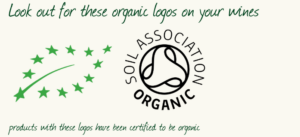
One of the biggest differences between organic and non-organic wine is the use of pesticides in the vineyard. If you don’t know, pesticides are synthetic chemicals designed to kill insects and other pests (insecticides), fungal diseases (fungicides) and weeds (herbicides). They’ve become very common in modern-day farming, and have unfortunately found their way into our food, soils, and waterways.
According to the UK’s Soil Association, of the 300 or so pesticides permitted under EU law, just 20 pesticides are permitted under organic standards, all of which derive from natural ingredients. Rather than use synthetic pesticides, organic vineyards will use methods like biological control, using cover cropping between vines and natural remedies to help maintain and improve soil health. All of this is done to have healthy organic grapes that result in wines with better flavours, aromas and terroir.
As the Soil Association points out, organic farms and vineyards can be havens for wildlife, and have up to 50% more wildlife than non-organic farms. So using more natural pesticides isn’t just better for the grapes, it’s also better for other wildlife too!
By choosing to drink organic wine, you’re supporting a viticulture system that’s more natural and better for the environment.
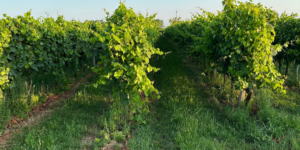
When talking about organic wine we should probably talk about soil health. Organic grape production depends first and foremost on the soil: balanced nutrition influences the fruit composition, which in turn influences the winemaking process.
Organic winegrowers and makers pay great attention to soil health, knowing that it’s very important for healthy grapes and the best possible wine. How do they do this? They use a variety of natural methods to improve soil health and fertility, including:
Soils are the source of nutrients for the vines and grapes. Healthier, biodiverse soils are simply better for vine health — and ultimately result in better quality wine too!

Under organic regulations, only certain additives of natural origin are allowed. Potentially dangerous and synthetic additives aren’t allowed or are restricted. Things like colouring agents and flavouring agents like malic acid aren’t allowed either. To find out more about additives in organic versus non-organic winemaking, see this document about organic wine from IFOAM. In addition, various techniques used for conventional winemaking aren’t allowed either. This includes things like the elimination of sulphur dioxide by physical processes, nano or ultra-filtration, and heat treatments above 70°C, among others.
Sulphur Dioxide (SO2) is the most widely used and controversial additive in winemaking. It’s used as an antiseptic to kill off unwanted bacteria, yeasts and moulds, and as an antioxidant to inhibit oxygen from spoiling the wine. An increasing number of people are sensitive or have allergic reactions to sulphur (headaches, wheeziness, a more groggy morning after feeling), and want to avoid it or ingest as little as possible. The good news is that organic wines have lower set levels generally, and we categorise our wines as having ‘LS’ (for Low Sulphur Wines) and ‘NS’ (for No Sulphur Added Wines), giving you the choice. Look out for these LS and NS symbols on our website.
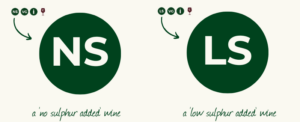
How do we define Low Sulphur Wines? From the low initial ‘organic status’ level, we’ve taken wines that are made with only 50% of that or less to be in this category. Our “No Sulphur” / “No Sulphur Added” wines are the wines with the lowest sulphur levels you will find anywhere. None at all is added, though tiny amounts can be produced as a natural by-product of the fermentation process.
One of the biggest threats to the organic wine industry and winemakers working hard to make clean organic wines is wines being labelled as organic when they are in fact not. This can happen on restaurant and bar menus, or in shops when retailers print their own labels saying a wine is organic when it hasn’t been certified. Just be careful, and to be sure you need to look out for certification. If a wine is certified, it will have either the EU organic logo, or one from another certifying body in the UK, such as the Soil Association logo, which is the largest certifying body in the UK. Don’t be fooled, and ask questions if you aren’t sure.

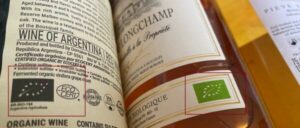
New to organic wines? All of our wines are indeed 100% organic. Here are some we’d recommend starting out with. You can also get £5 off your first wine order with us by signing up here.
Our Most Popular Organics Mixed Case is a great introduction to the quality of organic winemaking today.

Sale
Multiple Countries
£70.35 Original price was: £70.35.£68.00Current price is: £68.00.
Add to cart
Similarly, our Organic Everyday Mixed Case has six reliable top sellers – three organic reds and three organic whites.
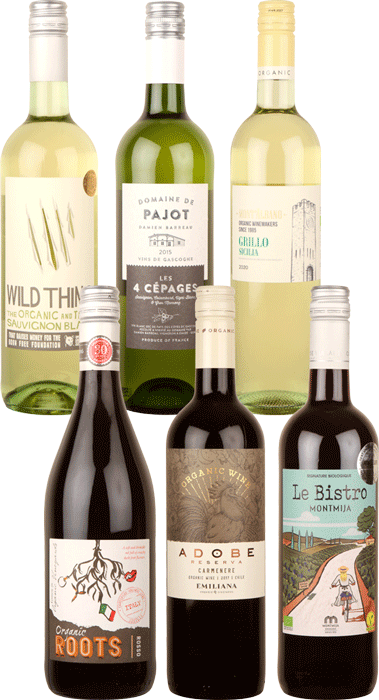
Sale
Multiple Countries
£64.20 Original price was: £64.20.£61.00Current price is: £61.00.
Add to cart
If you’re looking for a good selection of no sulphur added wines specifically, you might enjoy our No Sulphur Added Six Mixed Case, which has six flavour-packed no sulphur added reds.
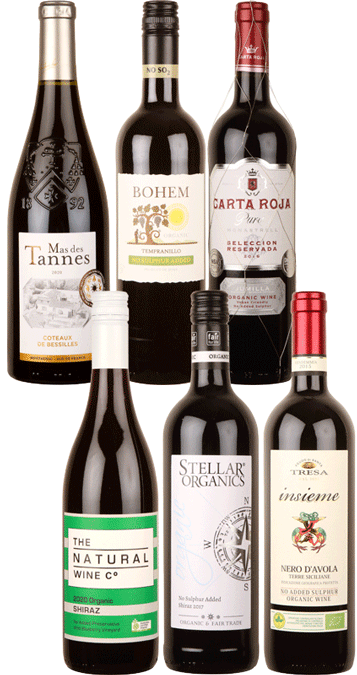
Multiple Countries
£69.00
Add to cart
If you’re a white wine lover, you’d likely enjoy our No Sulphur Added Whites Six mixed case.
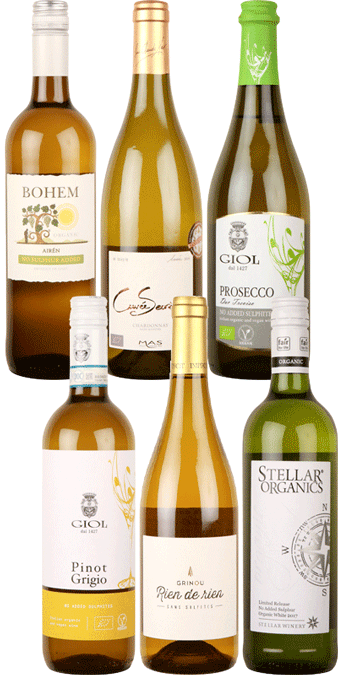
Sale
Multiple Countries
£74.75 Original price was: £74.75.£73.00Current price is: £73.00.
Add to cart
For more organic wine ideas, check out our list of 20 recommended organic wines to try or browse our bestselling organic wines here.
For more information about organic wines, also see our other blog posts:
The post What Is Organic Wine? appeared first on Vintage Roots: Organic Wine | Biodynamic Wines.
What does it mean if a wine is organic?

Put simply, organic wine is wine that’s made in accordance with organic winemaking standards. This means that the grapes grown in the vineyards will follow organic production standards and not rely on synthetic fertilisers and pesticides. In the winery, certain rules for organic winemaking must also be followed – you can find out more about this below. These organic wine rules were first put in place in 2012 in the UK and Europe.
Always be careful and look for certification to know whether a wine is organic (all of the organic wines we sell are). Beware of greenwashing – if a wine label does not have these symbols, it most likely has not been certified and technically can’t be called organic. Let’s break things down further to help explain what it means if a wine is organic.

What is organic wine: Pesticide use
One of the biggest differences between organic and non-organic wine is the use of pesticides in the vineyard. If you don’t know, pesticides are synthetic chemicals designed to kill insects and other pests (insecticides), fungal diseases (fungicides) and weeds (herbicides). They’ve become very common in modern-day farming, and have unfortunately found their way into our food, soils, and waterways.
According to the UK’s Soil Association, of the 300 or so pesticides permitted under EU law, just 20 pesticides are permitted under organic standards, all of which derive from natural ingredients. Rather than use synthetic pesticides, organic vineyards will use methods like biological control, using cover cropping between vines and natural remedies to help maintain and improve soil health. All of this is done to have healthy organic grapes that result in wines with better flavours, aromas and terroir.
As the Soil Association points out, organic farms and vineyards can be havens for wildlife, and have up to 50% more wildlife than non-organic farms. So using more natural pesticides isn’t just better for the grapes, it’s also better for other wildlife too!
By choosing to drink organic wine, you’re supporting a viticulture system that’s more natural and better for the environment.
What is organic wine: Soil health

When talking about organic wine we should probably talk about soil health. Organic grape production depends first and foremost on the soil: balanced nutrition influences the fruit composition, which in turn influences the winemaking process.
Organic winegrowers and makers pay great attention to soil health, knowing that it’s very important for healthy grapes and the best possible wine. How do they do this? They use a variety of natural methods to improve soil health and fertility, including:
- Farmyard composts consisting of animal manure or plant matter
- Minerals from natural sources, such as rock phosphate or potash
- Plant by-products such as wood chips, composted bark, wood ash and straw
- Seaweed and algal preparations
Soils are the source of nutrients for the vines and grapes. Healthier, biodiverse soils are simply better for vine health — and ultimately result in better quality wine too!
What is organic wine: Winemaking and additives

Under organic regulations, only certain additives of natural origin are allowed. Potentially dangerous and synthetic additives aren’t allowed or are restricted. Things like colouring agents and flavouring agents like malic acid aren’t allowed either. To find out more about additives in organic versus non-organic winemaking, see this document about organic wine from IFOAM. In addition, various techniques used for conventional winemaking aren’t allowed either. This includes things like the elimination of sulphur dioxide by physical processes, nano or ultra-filtration, and heat treatments above 70°C, among others.
What about sulphites in wine?
Sulphur Dioxide (SO2) is the most widely used and controversial additive in winemaking. It’s used as an antiseptic to kill off unwanted bacteria, yeasts and moulds, and as an antioxidant to inhibit oxygen from spoiling the wine. An increasing number of people are sensitive or have allergic reactions to sulphur (headaches, wheeziness, a more groggy morning after feeling), and want to avoid it or ingest as little as possible. The good news is that organic wines have lower set levels generally, and we categorise our wines as having ‘LS’ (for Low Sulphur Wines) and ‘NS’ (for No Sulphur Added Wines), giving you the choice. Look out for these LS and NS symbols on our website.

How do we define Low Sulphur Wines? From the low initial ‘organic status’ level, we’ve taken wines that are made with only 50% of that or less to be in this category. Our “No Sulphur” / “No Sulphur Added” wines are the wines with the lowest sulphur levels you will find anywhere. None at all is added, though tiny amounts can be produced as a natural by-product of the fermentation process.
Always be careful and look for certification!
One of the biggest threats to the organic wine industry and winemakers working hard to make clean organic wines is wines being labelled as organic when they are in fact not. This can happen on restaurant and bar menus, or in shops when retailers print their own labels saying a wine is organic when it hasn’t been certified. Just be careful, and to be sure you need to look out for certification. If a wine is certified, it will have either the EU organic logo, or one from another certifying body in the UK, such as the Soil Association logo, which is the largest certifying body in the UK. Don’t be fooled, and ask questions if you aren’t sure.


Recommended organic wines
New to organic wines? All of our wines are indeed 100% organic. Here are some we’d recommend starting out with. You can also get £5 off your first wine order with us by signing up here.
Our Most Popular Organics Mixed Case is a great introduction to the quality of organic winemaking today.

Sale
Most Popular Organics
Add to WishlistMultiple Countries
£70.35 Original price was: £70.35.£68.00Current price is: £68.00.
Add to cart
Similarly, our Organic Everyday Mixed Case has six reliable top sellers – three organic reds and three organic whites.

Sale
Organic Everyday
Add to WishlistMultiple Countries
£64.20 Original price was: £64.20.£61.00Current price is: £61.00.
Add to cart
If you’re looking for a good selection of no sulphur added wines specifically, you might enjoy our No Sulphur Added Six Mixed Case, which has six flavour-packed no sulphur added reds.

No Sulphur Added Six
Add to WishlistMultiple Countries
£69.00
Add to cart
If you’re a white wine lover, you’d likely enjoy our No Sulphur Added Whites Six mixed case.

Sale
No Sulphur Added Whites Six
Add to WishlistMultiple Countries
£74.75 Original price was: £74.75.£73.00Current price is: £73.00.
Add to cart
For more organic wine ideas, check out our list of 20 recommended organic wines to try or browse our bestselling organic wines here.
For more information about organic wines, also see our other blog posts:
- Why Drink Organic Wine? Six Reasons to Drink Organic Wine
- Complete Guide to Organic Wine
- Organic vs Biodynamic vs Natural Wine

The post What Is Organic Wine? appeared first on Vintage Roots: Organic Wine | Biodynamic Wines.
